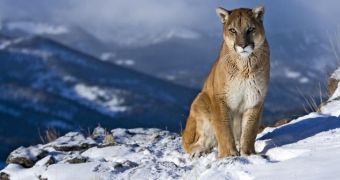As surprising as this may sound, it turns out that cougars have their highly adaptable taste buds to thank for the fact that they managed to survive the Pleistocene mass extinction some 12,000 years go.
Thus, in a paper published in the journal Biology Letters this April 23, a team of researchers explains that, according to evidence at hand, these animals made it through the Pleistocene mass extinction as a result of their not being picky eaters.
By comparison, the saber-tooth cat and the American lion, both of which were quite spoiled and particular about what they were going to have for breakfast, lunch or dinner, ended up falling off the biodiversity map.
“Before the Late Pleistocene extinction six species of large cats roamed the plains and forests of North America. Only two – the cougar and jaguar – survived,” specialist Larisa R.G. DeSantis explained in a statement, as cited by EurekAlert.
In order to establish whether or not their dietary preferences (or, better said, lack of) is what helped cougars make it through the Pleistocene mass extinction, researchers resorted to a technique known as dental microwear texture analysis.
What the scientists basically did was have a close look at teeth that used to belong to such felines and pin down microscopic wear patters. These patterns were then compared to those on teeth originating from saber-tooth cats and American lions, and hyenas, African lions and cheetahs.
Since each meal that an animal consumes leaves telltale marks on its teeth, the specialists were able to determine what the cougars that they focused on as part of this investigation had eaten during their last few weeks of life.
It was discovered that, when compared to saber-tooth cats and American lions, cougars had a rather varied diet. More precisely, some of the cougar teeth that were studied displayed wear patterns similar to the ones found on the teeth of hyenas, which have been documented to eat their prey almost in its entirety.
By comparison, saber-tooth cats and American lions had wear patterns similar to the ones documented in the case of African lions and cheetahs, both of which are known to be picky eaters. Thus, whereas African lions eat the meat and sometimes the bones of their prey, cheetahs more often than not settle for tender meat alone.
“This suggests that the Pleistocene cougars had a ‘more generalized’ dietary behavior. Specifically, they likely killed and often fully consumed their prey, more so than the large cats that went extinct,” Larisa R.G. DeSantis said.
The researchers say that the feeding behavior of cougars that lived thousands of years ago was not all that different to the one of such felines that roam the wild nowadays, and argue this species' varied diet is probably what helped them survive the Pleistocene mass extinction.

 14 DAY TRIAL //
14 DAY TRIAL //